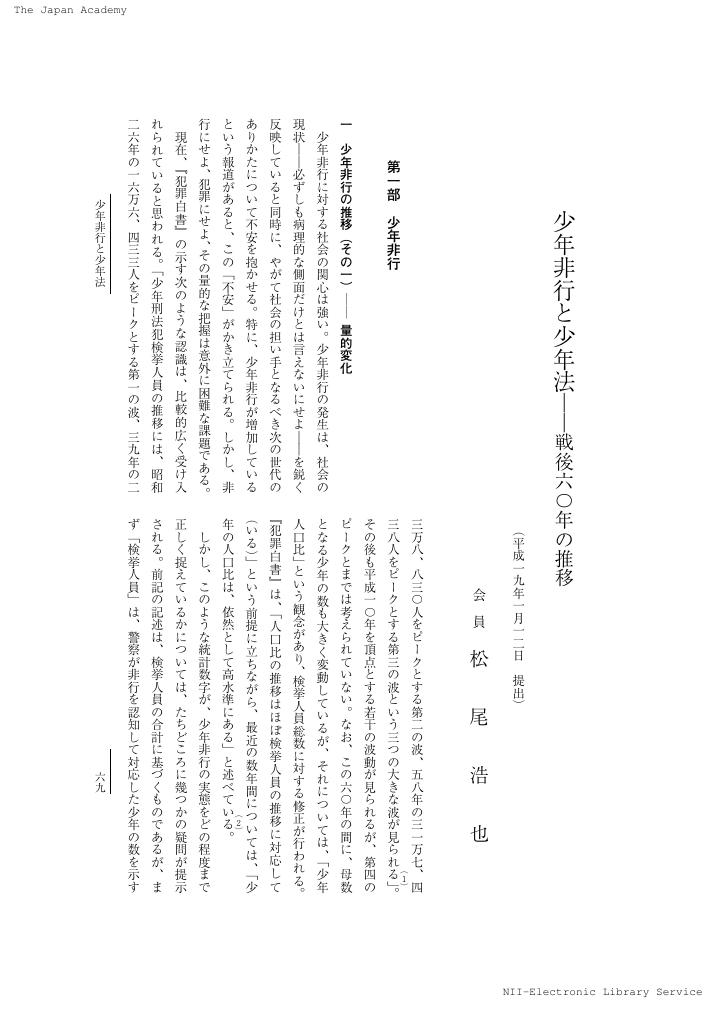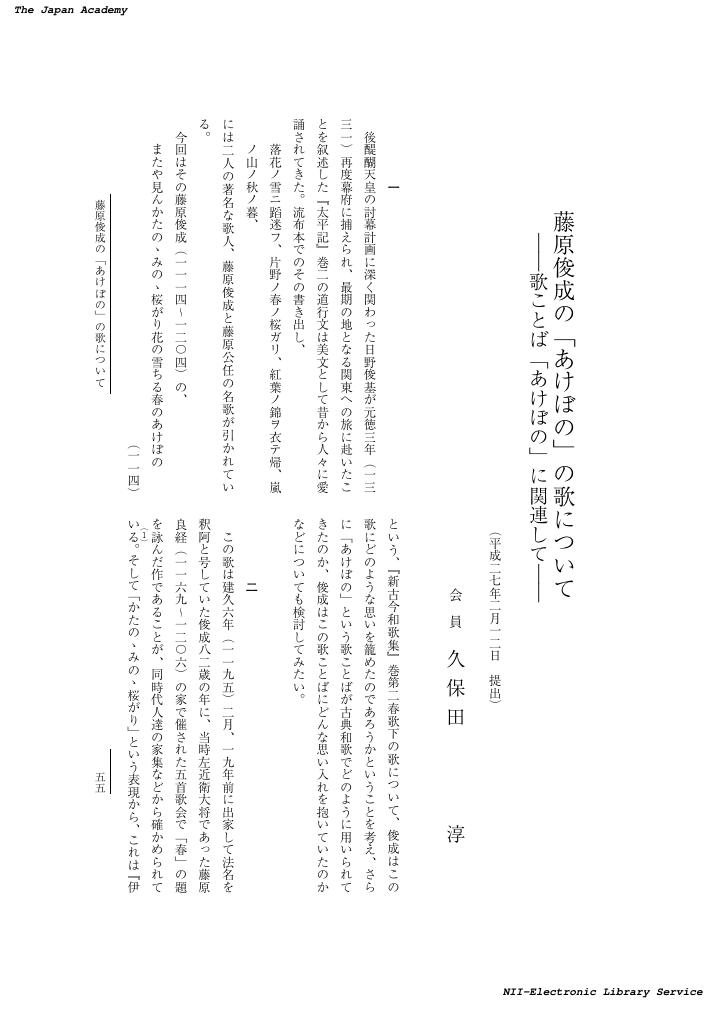2 0 0 0 OA 少年非行と少年法 : 戦後六〇年の推移
- 著者
- 松尾 浩也
- 出版者
- 日本学士院
- 雑誌
- 日本學士院紀要 (ISSN:03880036)
- 巻号頁・発行日
- vol.62, no.1, pp.69-80, 2007 (Released:2017-04-05)
2 0 0 0 中国における叙事詩から戯曲への道 : 英雄祭祀と英雄劇
- 著者
- 田仲 一成
- 出版者
- 日本学士院
- 雑誌
- 日本學士院紀要 (ISSN:03880036)
- 巻号頁・発行日
- vol.66, no.1, pp.1-29, 2011
2 0 0 0 OA 藤原俊成の「あけぼの」の歌について : 歌ことば「あけぼの」に関連して
- 著者
- 久保田 淳
- 出版者
- 日本学士院
- 雑誌
- 日本學士院紀要 (ISSN:03880036)
- 巻号頁・発行日
- vol.70, no.1, pp.55-70, 2015 (Released:2017-04-05)
- 著者
- 小田 滋
- 出版者
- 日本学士院
- 雑誌
- 日本學士院紀要 (ISSN:03880036)
- 巻号頁・発行日
- vol.62, no.1, pp.43-68, 2007
2 0 0 0 OA 行政法概念の諸相 : 中核と周辺
- 著者
- 塩野 宏
- 出版者
- 日本学士院
- 雑誌
- 日本學士院紀要 (ISSN:03880036)
- 巻号頁・発行日
- vol.66, no.1, pp.47-65, 2011-09
- 著者
- Yoshio ARAMAKI Tadashi YASUHARA Tsutomu HIGASHIJIMA Masanori YOSHIOKA Akiko MIWA Nobufumi KAWAI Terumi NAKAJIMA
- 出版者
- 日本学士院
- 雑誌
- Proceedings of the Japan Academy, Series B (ISSN:03862208)
- 巻号頁・発行日
- vol.62, no.9, pp.359-362, 1986 (Released:2006-10-10)
- 参考文献数
- 3
- 被引用文献数
- 46 75
- 著者
- Shin-ichi MAKINO Naoki AMANO Masashi SUZUKI
- 出版者
- 日本学士院
- 雑誌
- Proceedings of the Japan Academy, Series B (ISSN:03862208)
- 巻号頁・発行日
- vol.75, no.10, pp.311-316, 1999 (Released:2006-10-17)
- 参考文献数
- 5
- 被引用文献数
- 3 4
A new method is described for printing nucleotide sequences by assembling square microcells, representing nucleotides, into blocks, and by differentiating micro-cells following a color code, a gray scale, etc., corresponding to the four types of nucleotides. By printing micro-cells, whose sides are close to 250μm, using a laser printer, the complete sequence of a genome of the size close to 1M bases can be printed in the space of full size of A4, without loosing any original information. By enlarging the print using a magnifying glass or a photo-copy machine, the original sequence can be reconstituted, visually or mechanically. Overall and regional characteristics of genomes (e.g. distribution of gene-coding regions) can be analyzed using a plot of this type. The scheme for classifying micro-cells can be modified, in order to present different types of information such as distribution of purines and pyrimidines or that of different types of dinucleotide combinations through the genome.
2 0 0 0 OA アダム•スミスの「見えない手」について (平成七年十月十二日 提出)
- 著者
- 小林 昇
- 出版者
- 日本学士院
- 雑誌
- 日本學士院紀要 (ISSN:03880036)
- 巻号頁・発行日
- vol.50, no.3, pp.163-186, 1996 (Released:2007-06-22)
What I intend to do in this article is critically to examine Adam Smith's idea of‘invisible hand’, following the passages in which the phrase appears.As is known well, the phrase‘an invisible hand’appears three times, that is to say, once each in EPS, TMS and WN. Its appearance in EPS, however, does not imply any particular problem. And in the case of WN, there is also a place where the phrase is only implied, i. e. in its Book III, Chap. V (cf. A. Skinner, Introduction to the Pelican[Penguin]Classicsed. of the WN.).In TMS the phrase‘invisible hand’is made use of surrounded by the ancient Stoic creed on which the philosopher Smith is based. In that sense the phrase is outside the theory of sympathy which constitutes the basis of TMS, and the theory of so-called‘deception’used there in the sense that men's misfortune, mistakes and mere selfish acts contribute to the realization of the harmony of the whole society is not sufficient for the possibility of the formation of modern exchange economy society.In WN the phrase‘an invisible hand’totally implies a force to bring about an eventual harmony and welfare in the modern liberal society, and the function of this force is based on the formation of the theories of natural course (order) of the employment of capital. However, the collapse of the theory as such is evident. Moreover, since J. Viner's treatise pointed out, it is well known that Smith is not exhaustive in the criticism of so-called mercantilism, the work of the‘invisible hand’is confined.In Book III of WN, a transcendental power is talked of to cause a great revolution by its action on unworthy common men, where Smith's historical philosophy is evinced which somehow resembles Hegel's‘List der Vernunft’. But such a work in fact of the‘invisible hand’appears only once, and merely implicitly in WN so that Smith's elucidation here does not have universal validity.Quite naturally, the phrase‘an invisible hand’is a symbolic term which a particular age gave birth to and therefore, so far as it goes it can be the object of academic analysis but not its means.
- 著者
- Motohide TAMURA
- 出版者
- 日本学士院
- 雑誌
- Proceedings of the Japan Academy, Series B (ISSN:03862208)
- 巻号頁・発行日
- vol.92, no.2, pp.45-55, 2016-02-10 (Released:2016-02-10)
- 参考文献数
- 66
- 被引用文献数
- 3 21
The first convincing detection of planets orbiting stars other than the Sun, or exoplanets, was made in 1995. In only 20 years, the number of the exoplanets including promising candidates has already accumulated to more than 5000. Most of the exoplanets discovered so far are detected by indirect methods because the direct imaging of exoplanets needs to overcome the extreme contrast between the bright central star and the faint planets. Using the large Subaru 8.2-m Telescope, a new high-contrast imager, HiCIAO, and second-generation adaptive optics (AO188), the most ambitious high-contrast direct imaging survey to date for giant planets and planet-forming disks has been conducted, the SEEDS project. In this review, we describe the aims and results of the SEEDS project for exoplanet/disk science. The completeness and uniformity of this systematic survey mean that the resulting data set will dominate this field of research for many years.
- 著者
- Taro KUSAGAYA Hiroyuki K. M. TANAKA
- 出版者
- 日本学士院
- 雑誌
- Proceedings of the Japan Academy, Series B (ISSN:03862208)
- 巻号頁・発行日
- vol.91, no.9, pp.501-510, 2015-11-11 (Released:2015-11-11)
- 参考文献数
- 30
- 被引用文献数
- 21
In conventional muography observations using two detectors for muon tracking, the accidental coincidence of vertical electromagnetic showers generates identical trajectories to the muon tracks. Although muography has favorable properties, which allow direct density measurements inside a volcano, the measured density is lower than the actual value due to these fortuitous trajectories. We performed muography of Usu volcano, and confirmed that, in comparison with a use of two detectors, background noise levels were reduced by more than one order of magnitude using seven detectors for selecting linear trajectories. The resultant muographic image showed a high-density region underneath the central region of Usu volcano. This picture is consistent with the magma intrusion model proposed in previous studies. To clarify the three-dimensional location and actual size of the detected high-density body, multidirectional muographic measurements are necessary.
2 0 0 0 「市川文吉送別文集」について--いわゆる幕末洋学者欧文集
- 著者
- 日本学士院
- 出版者
- 日本学士院
- 雑誌
- 日本学士院紀要 (ISSN:03880036)
- 巻号頁・発行日
- vol.35, no.2, pp.p1-37,巻頭p1〜2, 1978-03
- 著者
- YAGI Hidetsugu UDA Shintaro
- 出版者
- 日本学士院
- 雑誌
- Proceedings of the Imperial Academy (ISSN:03699846)
- 巻号頁・発行日
- vol.2, no.2, pp.49-52, 1926
- 被引用文献数
- 53
2 0 0 0 OA 社会階級・社会階層と経済社会学
- 著者
- 富永 健一
- 出版者
- 日本学士院
- 雑誌
- 日本學士院紀要 (ISSN:03880036)
- 巻号頁・発行日
- vol.68, no.2, pp.139-179, 2014-02
2 0 0 0 戦前日本のアメリカ研究 : 素描
- 著者
- 斎藤 眞
- 出版者
- 日本学士院
- 雑誌
- 日本學士院紀要 (ISSN:03880036)
- 巻号頁・発行日
- vol.55, no.2, pp.81-103, 2000
- 著者
- 久保 正彰
- 出版者
- 日本学士院
- 雑誌
- 日本學士院紀要 (ISSN:03880036)
- 巻号頁・発行日
- vol.61, no.2, pp.45-64, 2007-01
2 0 0 0 OA “Human Rights”と“droits de l'homme”の含意をめぐって
- 著者
- 樋口 陽一
- 出版者
- 日本学士院
- 雑誌
- 日本學士院紀要 (ISSN:03880036)
- 巻号頁・発行日
- vol.57, no.2, pp.47-63, 2002 (Released:2007-06-22)
Quant au terme de“droits de l'homme”, notion clé du constitutionnalisme contemporain, it faut bien distinguer entre les deux. Les droits de l'homme lato sensu peuvent se définir comme une revendication, regardée légitime, pour la possibilité de mener une vie d'une façon humaine. Le terme anglais Human Rights aurait d'ailleurs cette résonnance. Or, queue est la façon humaine de mener une vie? La réponse dépendrait du contenu de l'adjectif “humain”, et elle serait nécessairement variable d'une culture à l'autre. À l'extrême, être tout dévoué à la communauté à laquelle on appartient, pourrait être regardé comme la manière la plus “humaine”de vivre dans telle ou telle société.S'agissant des droits de l'homme stricto sensu, ils présupposeraient, comme titulaire des droits, l'individu“doppelfrei”, libéré à la fois de l'oppression et de la protection des corps statutaire et féodal. Les droits de l'homme, entendus dans ce sens strict, sont les produits historiques de la modernité individualiste d'origine occidentale. Ile ne peuvent pas être dissociés de la notion de l'individu qui se décide et qui assume la conséquence de sa propre décision, tandis que les droits de l'homme lato sensu pourraient s'adapter à une conception plus on moms communautariste.Les droits de l'homme stricto sensu exige ainsi une manière de vivre qui semblerait, du point de vue de certaines cultures, être plutôt“inhumaine”. Même au sein de la zone culturelle occidentale, la croyance en la vertue de l'individu se trouve de moins en moins certain, et la tentation même à la démission de l'individu risque de se propager (“Escape from Freedom”).Ainsi, un sceptisme à l'égard de la notion de l'homme titulaire des droits de l'homme stricto sensu fermente, depuis des decennies, dans le milieu intellectuel. L'accusation est lancée surtout del apart du femminisme et du multiculturalisme d' après laquelle la notion même des droits de l'homme serait anachronique et dépassée.Tout en respectant la pluralité des cultures en général, comment défendre le noyau essentiel des droits de l'homme, la liberté reconnue à chacune et à chacun de choisir sa propre identité? La culture des droits de l'homme peut se concilier avec l'exigence légitime de la pluralité des cultures, tant que ces dernières acceptent ce noyau dur. Or, il ya bien des cultures qui refusent, au nom de leur tradition ou de leur identité collective, la prémisse même d'une coexistence avec la culture des droits de l'homme. Le véritable enjeu émerge ainsi.
2 0 0 0 OA トマス•モーアとフランソワ•ラブレー (昭和四十三年十二月十二日提出)
- 著者
- 渡辺 一夫
- 出版者
- 日本学士院
- 雑誌
- 日本學士院紀要 (ISSN:03880036)
- 巻号頁・発行日
- vol.27, no.2, pp.85-101, 1969 (Released:2007-05-30)
2 0 0 0 OA アダム•スミスの「見えざる手」の諸解釈について (昭和六十二年五月十二日 提出)
- 著者
- 山田 雄三
- 出版者
- 日本学士院
- 雑誌
- 日本學士院紀要 (ISSN:03880036)
- 巻号頁・発行日
- vol.42, no.3, pp.193-208, 1987 (Released:2007-06-22)
Adam Smith used the phrase‘invisible hand’only in one place in the Wealth of Nations. But his thinking expressed by this phrase is found throughout the book.The thinking of Adam Smith is not easy to be interpreted, for many sources of thought at that time have been holded in his thinking. We must tackle with problems as to religious faith versus knowledge, individual versus social and normative versus positive.After Adam Smith, most of rationalists make efforts to visualize‘invisible hand’by the formation of equilibrium theory of perfectly competitive market. However, from empirical point of view, the idea of general equilibrium in perfect competition seems to be dubious, although the idea of partial equilibrium is empirically admitted. Some interpreters insist on‘invisible hand’as the individualistic and spontaneous order without governmental interventions. But other interpreters admit intervention or planning, not wholly but partially, as far as individuals are not necessarily rational.In conclusion, it seems to me that Smithian phrase‘invisible hand’becomes a subject of discussion even today. Here, I want to refer, according to K. Popper, to the words of a greek philosopher:“Nicht vom Beginn an enthüllen die Götter uns Sterblichen alles. Aber im Laufe der Zeit finden wir, suchend, das Bess're.”
2 0 0 0 OA 平安・鎌倉時代における二、三の名所について
- 著者
- 久保田 淳
- 出版者
- 日本学士院
- 雑誌
- 日本學士院紀要 (ISSN:03880036)
- 巻号頁・発行日
- vol.66, no.3, pp.115-129, 2012-03
2 0 0 0 OA 国際法の実務家に徹した60年 : 日本の法学者として特異な体験を振り返る
- 著者
- 小田 滋
- 出版者
- 日本学士院
- 雑誌
- 日本學士院紀要 (ISSN:03880036)
- 巻号頁・発行日
- vol.65, no.1, pp.31-73, 2010-09








